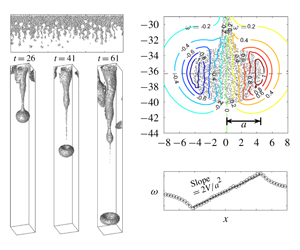Article contents
Formation of drops and rings in double-diffusive sedimentation
Published online by Cambridge University Press: 17 December 2019
Abstract

We conduct numerical simulations to investigate the formation and evolution of drops and vortex rings of particle-laden fingers in double-diffusive convection in stably stratified environments. We show that the temporal evolution can be divided into double diffusion, acceleration and deceleration phases. The acceleration phase is a result of the vanishing temperature perturbation in the drop during the descent in the layer of uniform temperature. The drop decelerates because it transforms into a vortex ring. A theoretical drag model is presented to predict the speed of the spherical drop with the low drop Reynolds number. By formulating the boundary condition based on the vorticity, our drag model gives a more general form of the drag coefficient for small spherical drops and shows good agreement in predicting the drag coefficient. Drops with five particle sizes are compared, and it is found that although the greater vertical settling enhances vertical transport, the final state differs little among the various sizes. Comparison of our drag model with the simulation results under various bulk conditions and previous experimental results shows good model predictability. Finally, a comparison with the salt-finger case shows that the diffusive nature of the dissolved scalar field, along with the wake effect, can result in an apparent loss of mass from the drop and a permanent presence of the connection between the drop and its parent finger. This makes the observed detachment of the particle-laden drop much less likely in the salt-finger case.
- Type
- JFM Papers
- Information
- Copyright
- © 2019 Cambridge University Press
References
- 5
- Cited by


